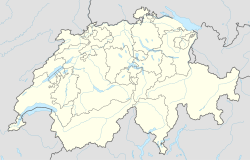Courlevon
| Courlevon | ||
|---|---|---|
| Former municipality of Switzerland | ||
 |
||
|
||
| Coordinates: 46°53′N 7°7′E / 46.883°N 7.117°ECoordinates: 46°53′N 7°7′E / 46.883°N 7.117°E | ||
| Country | Switzerland | |
| Canton | Fribourg | |
| District | See or du Lac | |
| Government | ||
| • Executive |
Gemeinderat with 5 members |
|
| • Mayor | Ammann | |
| Area | ||
| • Total | 3.27 km2 (1.26 sq mi) | |
| Elevation | 556 m (1,824 ft) | |
| Population (Dec 2014) | ||
| • Total | 305 | |
| • Density | 93/km2 (240/sq mi) | |
| Postal code | 1795 | |
| SFOS number | 2251 | |
| Localities | Courlevon, Coussiberlé | |
| Surrounded by | Courgevaux, Cressier, Münchenwiler (BE), Villarepos, Wallenried | |
| Website |
www SFSO statistics |
|
Courlevon is a former municipality in the district of See or du Lac in the canton of Fribourg in Switzerland. On 1 January 2016 the former municipalities of Courlevon, Jeuss, Lurtigen and Salvenach merged into Murten/Morat.
Courlevon is first mentioned in 1214 as Curlivin.
Courlevon had an area, as of 2009[update], of 3.3 square kilometers (1.3 sq mi). Of this area, 1.87 km2 (0.72 sq mi) or 57.4% is used for agricultural purposes, while 1.23 km2 (0.47 sq mi) or 37.7% is forested. Of the rest of the land, 0.17 km2 (0.066 sq mi) or 5.2% is settled (buildings or roads).
Of the built up area, housing and buildings made up 4.3% and transportation infrastructure made up 0.6%. Out of the forested land, 35.6% of the total land area is heavily forested and 2.1% is covered with orchards or small clusters of trees. Of the agricultural land, 42.9% is used for growing crops and 13.8% is pastures.
The former municipality is located in the See/Lac district. On 15 February 1974 the former municipality of Coussiberlé merged into the municipality of Courlevon.
The blazon of the municipal coat of arms is Gules, a Horse passant Argent.
Courlevon had a population (as of 2014[update]) of 305. As of 2008[update], 9.1% of the population are resident foreign nationals. Over the last 10 years (2000–2010) the population has changed at a rate of 17.6%. Migration accounted for 21.2%, while births and deaths accounted for -1.2%.
...
Wikipedia




